 Mobile-friendliness has become paramount in the digital age, and e-commerce site search is no exception. The effectiveness of site search has become a critical factor in shaping the user experience and driving conversion rates.
Mobile-friendliness has become paramount in the digital age, and e-commerce site search is no exception. The effectiveness of site search has become a critical factor in shaping the user experience and driving conversion rates.
It serves as the digital gateway for customers to navigate through vast product catalogs efficiently. Its significance lies in providing users with a seamless and intuitive way to find relevant items, enhancing user satisfaction and engagement.
Here, we explain the nuances of e-commerce site search and list down 15 things you can do to ensure a smooth shopping experience for your store visitors.
What Is E-commerce Site Search?
An e-commerce site search solution is a search engine that you can integrate or build into your online store. Its function is to match the products in your store with the user’s search phrases, helping them locate the things they’re looking for.
Search engines for e-commerce and Google search are somewhat comparable. While Google does text-based content searches, e-commerce search uses structured attribute search with important capabilities like filtering and sorting.
Approximately 43% of users head straight to the search box, when they shop online. With the growing trends in e-commerce marketing, technology, and customer expectations, search is becoming an increasingly effective tool for helping customers find the products they want.
Benefits of E-Commerce Site Search
A well-functioning site search acts as a lighthouse, guiding customers effortlessly towards their desired products. A robust search tool within your store offers a multitude of benefits for both businesses and customers, making it a crucial element for any successful e-commerce endeavor.
-
Enhanced User Experience
A seamless search experience saves time and frustration, allowing customers to find what they need quickly and easily. This translates to increased satisfaction and a higher likelihood of returning to your store.
-
Boosted Sales & Conversions
Efficient site search directly translates to increased sales. By guiding users to the products they seek, you minimize the chances of them abandoning their search and leaving empty-handed.
According to a study, user-friendly site searches result in greater conversion rates. The conversion rate increased from the websites’ average of 2.77% to 4.63% when site search was implemented. That is a rise of 80%!
-
Reduced Bounce Rates & Improved SEO
A well-functioning search engine keeps users engaged on your website, reducing bounce rates and improving dwell time. This can also positively impact your website’s ranking in search engine results pages (SERPs), attracting more organic traffic.
-
Informed Product Development
By analyzing search trends and identifying frequently searched but unavailable products, businesses can gain valuable insights into customer demand and make informed decisions about product development and inventory management.
-
Increased Brand Loyalty
A positive search experience fosters trust and loyalty, encouraging customers to return to your store for future purchases.
15 E-commerce Site Search Best Practices for 2024
A well-crafted search bar isn’t just about finding products, it’s about creating a joyful shopping journey that keeps customers coming back for more. You can transform your search bar from a simple input field to a powerful conversion tool using some of these methods.
1. Prominence and Visibility
Don’t hide your search bar, rather place it prominently on every page, easily accessible from all devices. The upper right corner is the best location for an e-commerce search box, as 17% of users start there before shifting to the top-left.
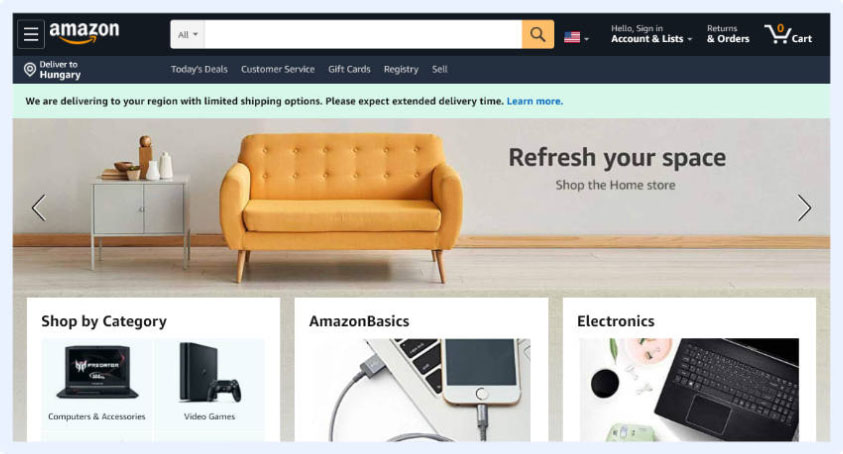
(Image courtesy Amazon)
2. Use Different Colors and Fonts
To draw attention and set the search box apart from other portions of the page, outline it with a color that contrasts with the site’s primary color scheme. You may also add more contrast to the search box by using a different font.
3. Good Design
A well-designed site search box should be able to clearly communicate its goals and features. Provide a well-known search symbol, like a magnifying glass, to make it obvious what the box is used for. The word “Search” is often used as a prompt on websites. You may also include an interactive “Search” or “Go” button.
Ensure that the search box is long enough to fit the majority of queries made on your website. If you are worried about everything fitting, make the search box expandable.
For instance, Ebay’s site search includes a bright blue “Search for anything” placeholder text, an icon that looks like a magnifying glass, and a search button.

(Image courtesy eBay)
4. Autocomplete and Error Correction
It is unrealistic to assume that customers will know the names of the products, how to spell them, or even what they are actually shopping for. Make sure the search function on your website is set up to recognize typos and phonetic misspellings so that basic errors don’t result in an empty results page.
When a customer types, your site’s search tool should be able to predict where the search will go and start displaying suggestions. This saves time and guides them directly to what they’re looking for. Below is an example of error correction.
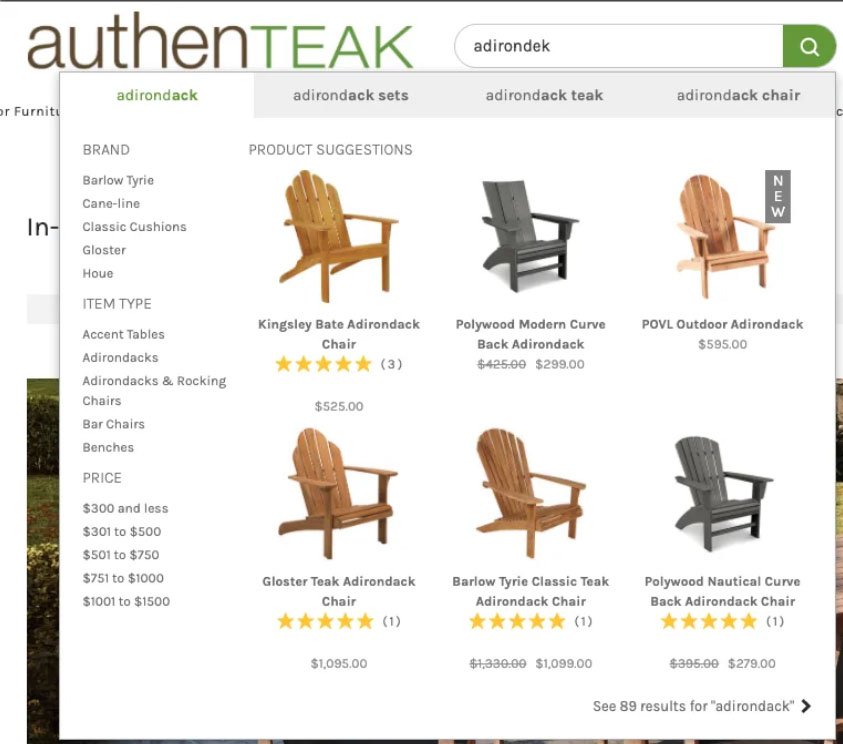
(Image courtesy Authenteak)
5. Use NLP To Understand User Intent
The need for natural language processing (NLP) in search has grown, making it possible to get accurate responses even in situations when the user is unable to articulate their search query. NLP-based search, which is being used by companies like Google, is a component of e-commerce and is actually improving the online shopping experience. For instance, users might search for “light”. By utilizing NLP it will interpret their intent and deliver appropriate results.
When NLP and voice recognition technology are combined with e-commerce site search, it’s called enhanced voice commerce. This allows users to make voice-activated searches and finish transactions.
Voice recognition technology, with a market value of around $11 billion and still rising, is critical to the future of search tools. Voice-activated purchasing is one of the main causes of this tremendous rise.
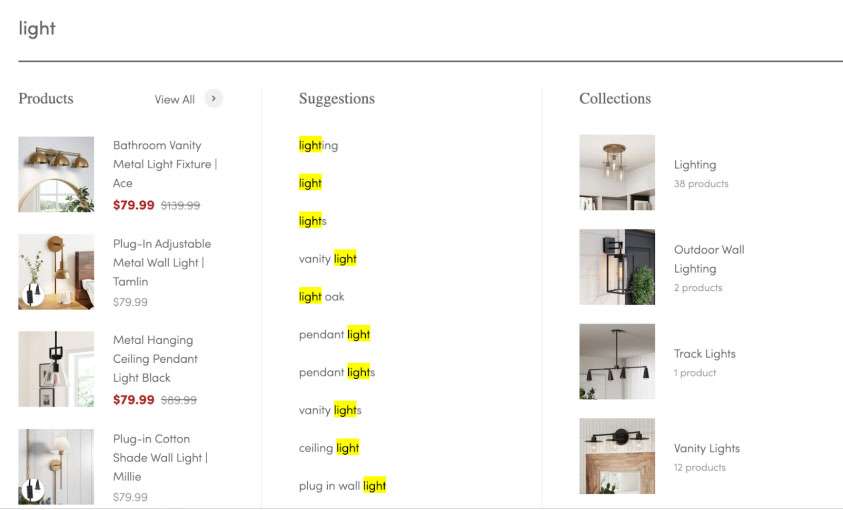
6. Plenty of Options for Filtering
Allowing visitors to quickly filter search results is crucial for helping them locate the products or material they seek. An efficient approach to achieve this is to provide filters that allow results to be narrowed down based on categories, brand, color, price, size, and other relevant attributes.
This allows users to refine their search with precision. For instance, consider a situation where a consumer is shopping for a new laptop. After applying a CPU type filter, they decided on an Intel i7 and reduced the screen’s dimensions to 15 inches.
They finally sorted by storage size, deciding that an SSD with at least 512 GB was necessary. With the help of the advanced search filters, your client was able to locate the perfect laptop that satisfied his/her requirements for performance, size, and storage in a matter of seconds.
7. Personalization
Leverage user data and purchase history or past choices to suggest relevant products and categories. This creates a personalized shopping experience like having a virtual assistant curate your options.
8. Instant and Automatic
It is recommended that search results, filters, autocomplete, and breadcrumbs be displayed automatically while a user types to reduce confusion and boost the probability of selecting a result.
9. Never Let a Web Search Come To a Standstill
No results and error messages result in a confusion and frustrating experience that sends customers fleeing. You can avoid this by suggesting similar terms to guide them back on track. You can also turn these scenarios into opportunities, by suggesting popular categories, and showcasing trending products, or providing a chat option for customer support.
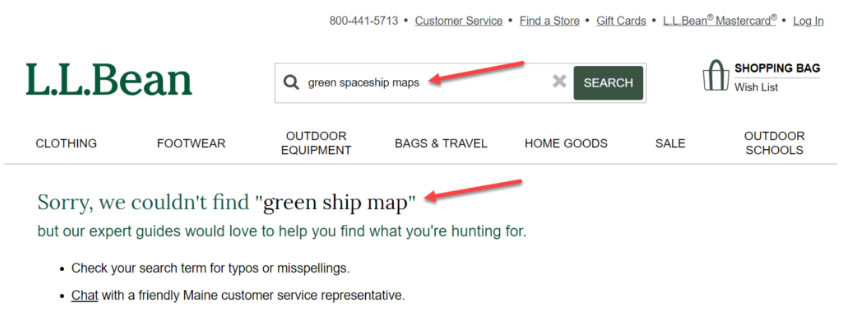
(Image courtesy L. L. Bean)
10. Optimize Mobile Search
The number of mobile devices used for e-commerce is steadily rising, and the ease of use of different payment options throughout the entire buying process, right from the point of sale to the point of checkout, contributes to this trend. Mobile shoppers are predicted to make up 44.2% of all online transactions by 2025.
Thus it’s critical to ensure that your website’s search is optimized for mobile devices as well. By minimizing the amount of input required, intelligent autocomplete suggestions or query suggestions, can be an effective tool to keep mobile searchers on the move.
If users of mobile devices find it difficult to use your mobile search box, you’re going to lose business. For instance, jewelry company Moriaty’s Gem Art benefited by enhancing the visibility of its mobile search bar.

(Image courtesy Moriartys)
11. Include It on Every Page
A visitor should be allowed to edit his query after typing it and hitting enter. It is meaningless to return to the previous page to look for the search box, in turn ruining user experience. The only exception is the cart page. It’s better to avoid putting a search box there as it may cause visitors to leave before completing their purchases.
12. Include Images and Add-To-Cart Buttons
Consider including images as users may need to see some pictures before deciding to buy a product. Also provide a “Buy Now” or “Add to Cart” button to allow potential customers to make their purchases from you. Studies reveal that people can only remember 20% of what they read, but when information is accompanied by a visual, their retention rate rises to 65%.
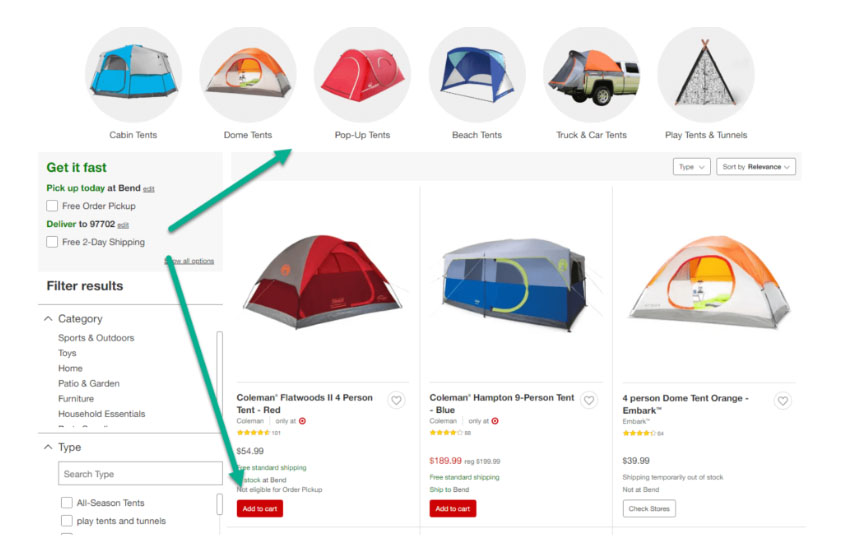
13. Use Augmented Reality (AR)
Integrating AR into e-commerce site search represents a revolutionary leap in enhancing the online shopping experience. AR technology allows users to visualize products in their physical space before making a purchase decision.
In the context of site search, this means users can virtually try out furniture, clothing, or other items using their device’s camera. This not only boosts customer confidence in their purchases but also significantly reduces return rates by aligning customer expectations with the actual product.
Furthermore, AR-driven site search fosters user engagement, setting a brand apart in a competitive market. As AR technology continues to evolve, its integration into site search is poised to redefine the future of online shopping, creating a more dynamic and immersive retail environment for consumers.
14. Blockchain-Powered Search
Implementing blockchain technology in e-commerce site search introduces a new paradigm of security, transparency, and trust. Blockchain-powered search in e-commerce revolutionizes how data is stored, accessed, and validated.
The decentralized and immutable nature of blockchain ensures the integrity of product information, eliminating concerns related to counterfeit products and unauthorized alterations. By leveraging blockchain for site search, businesses can enhance the transparency of their supply chains.
Blockchain-driven search fosters a decentralized and peer-to-peer marketplace, reducing reliance on intermediaries. As the e-commerce landscape evolves, the integration of blockchain into site search not only ensures a secure and transparent environment but also positions businesses at the forefront of technological innovation and consumer trust.
15. Cross-Channel Search Integration
Cross-channel search integration in e-commerce site search is a strategic approach that unifies the search experience across various platforms, creating a seamless and cohesive journey for users. By synchronizing search functionalities across websites, mobile apps, and social media, businesses can enhance user engagement and conversion rates.
This integration ensures a consistent and familiar search experience, regardless of the channel users choose. For instance, a user searches for a pair of running shoes on an e-commerce website.
The integrated system recognizes the user’s search history and preferences. Later, when the user opens the mobile app, they receive personalized recommendations for running shoes, aligning with their initial search.
Additionally, if the user interacts with the brand’s social media pages, they might encounter targeted ads featuring the same or similar running shoes. In this example, cross-channel search integration ensures that the user’s search data and preferences are shared and synchronized across different platforms.
The user enjoys a consistent and tailored experience, whether on the website, mobile app, or social media. This not only fosters user satisfaction but also enables the e-commerce brand to deliver targeted content and promotions based on the user’s cross-channel interactions, creating a cohesive and personalized customer journey.











